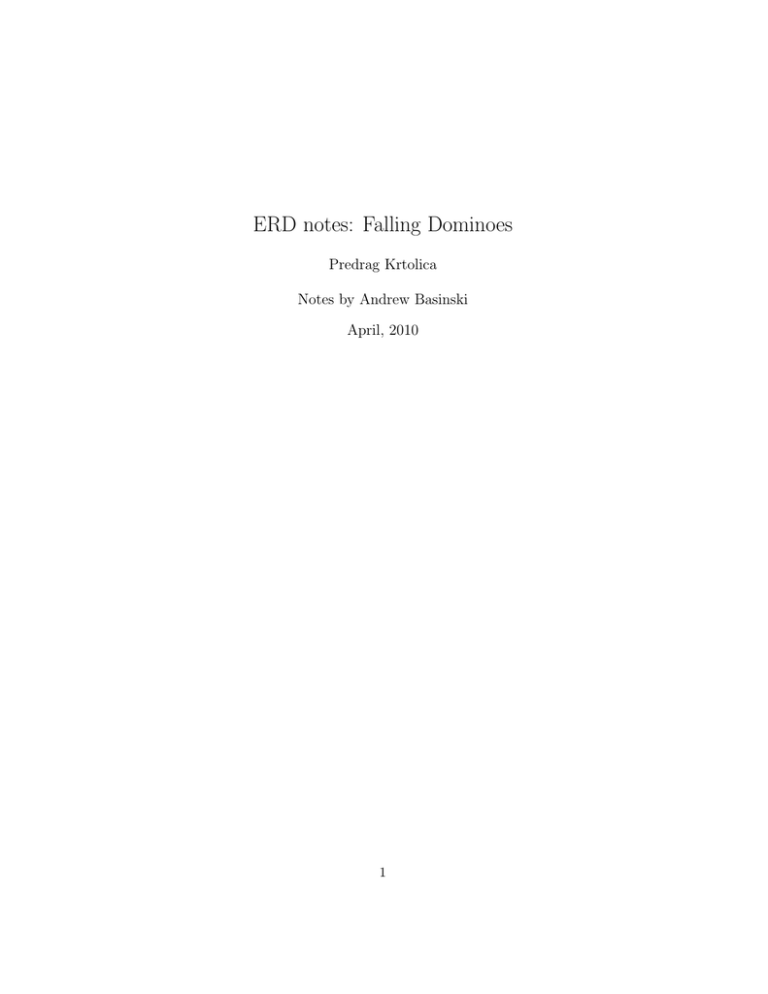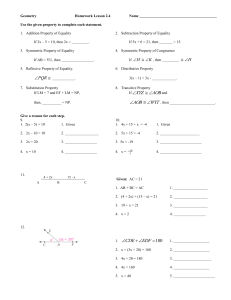ERD notes: Falling Dominoes Predrag Krtolica Notes by Andrew Basinski April, 2010
advertisement

ERD notes: Falling Dominoes Predrag Krtolica Notes by Andrew Basinski April, 2010 1 Assumptions: Several simplifying assumptions were used in the analysis below. They are • All dominoes have perfect dimensions of height h, thickness d, width l, and mass m. The dominoes are numbered from the first to the nth , where the nth is at the front of the chain. Domino i is donoted Di . • The dominoes only rotate when in contact - there is no skidding. • The spacing between dominoes is constant, and denoted s. • Dominoes stay in contact with one another once they’ve made initial contact. Thus fallen dominoes at the start of the chain continuously push on the back end of the chain. Initial Push: The moment of inertia around the axis of rotation of a domino must first be calculated. Let Icm be the moment of intertia p around the domino’s center of mass rotated in the y-z plane. Let r = z 2 + y 2 be the distance between a point on the domino and the x-axis. Then Z Icm = r2 dm v Z = l 2 − 2l = Z d 2 − d2 Z h 2 −h 2 m 2 (z + y 2 )dzdydx hdl m 2 1 (h + d2 ) = ma2 12 3 With a being the half-diagonal of the domino. To get the moment of intertia of rotation around the edge of the domino, we use the parallel axis theorem to obtain the moment of intertia around the edge as 4 1 I = Icm + ma = ma2 = m(h2 + d2 ). 3 3 Denote by γ the angle between the vertical and half diagonal when the h domino is at rest. Clearly γ = cos−1 ( 2a ). Denote by φ the position angle - that is, the angle between the vertical and diagonal while the domino is falling. At rest, we see that φ = −γ. A domino falls on its own accord when φ > 0 ⇒ s > hcos( π hd − γ) = hsinγ = 2 2a 2 Figure 1: Picture of domino with center of mass indicated by green dot. Note that the domino rotates on the x-axis. If p = (x, y, z)p is an arbitrary point on the domino, then the distance to the x-axis is r = z 2 + y 2 . 3 d Thus we require ⇒ hs > 2a for the domino effect to occur. It is clear that we must also have s < h. The minimum energy to put the domino in the unstable state is Emin = mg(a − p h 1 ) = mg( d2 + h2 − h) 2 2 . Pedrag then calculates the minimum angular velocity needed to reach the tipping point. By the law of conservation of energy, we must have P Eφ=θ + KEφ=θ = P Eφ=−γ + KEφ=−γ 1 1 mgacos(θ) + Iw2 = mgacos(γ) + Iw02 2 2 Where Eφ=θ is the total energy of the domino at angle −γ < θ < ξ. Solving for w gives r 3g w = w02 + (cosγ − cosθ) 2a . Setting θ = 0 gives the angular velocity at the tipping point: r 3g wtp = w02 + (cosγ − 1) 2a . But then we must have an intitial angular velocity of r 3g (1 − cosγ) wmin = 2a . Shaw’s Motion Constraints: This section elaborates on the idea that dominoes, once fallen, forever remain in contact with their neighbor. From the picture below (figure 2) we see that α = θi − θi+1 . (1) ˆ 0 − d = (s + d)cosθi+1 − d ˆ = AB AB (2) and Using equation (1), we obtain ˆ = hsin(θi − θi+1 ). AB 4 (3) Figure 2: 2-D picture of falling dominoes. From the picture we can see that α = θi − θi+1 . 5 Using the previous two equations, we obtain Shaw’s motion constraint: hsin(θi − θi+1 ) = (s + d)cosθi+1 − d (4) Defining θi = fn−i (thus a function describing a recurrence relation), and solving for θi we see −1 (s + d)cos(fj−1 (θn )) − d fj (θn ) = fj−1 (θn ) + sin h with f0 (θn ) = θn . The figure above shows that d π − θ∞ ) = cosθ∞ = 2 s+d Which implies the stacking angle, θ∞ is d −1 θ∞ = cos s+d sin( . The No Skidding Assumption The last topic presented in Pedrag’s talk was the no-skidding assumption. This gives a strict upper bound on the distance between dominoes. To ensure that domino Di rests on Di+1 as θi → θ∞ , (s + d)2 − d2 < h2 Let θi+1 = θ∞ − δi+1 where δi+1 is small. Equation (4) gives hsin(θi − θi+1 ) = (s + d)cosθi+1 − d hsin(θ∞ − δi − θ∞ + δi+1 ) = (s + d)cos(θ∞ − δi+1 ) − d h(δi+1 − δi ) = (s + d)(cosθ∞ cosδi+1 + sinθ∞ sinδi + 1) − d d h(δi+1 − δi ) = (s + d) 1 + sinθ∞ δi+1 − d s+d h(δi+1 − δi ) = (d + (s + d)sinθ∞ δi+1 ) − d s+d δi = 1 − sinθ∞ δi+1 h Thus δi → 0 exponentially. δi becomes negative when equation (4) is violated since then we have 6 (s + d)sinθ∞ = p (s + d)2 − d2 > h . This implies a violation of the Shaw Motion constraint. Conclusion: Predrag’s paper continues to finding the Asymptotic Approximation of the Propagation Wave - however, this was not covered in the talk. See Predrag for the full paper. 7







